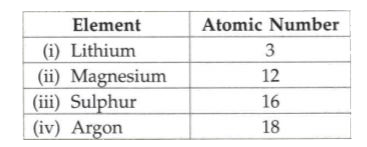Write the valence shell electronic configuration of group 16 elements and discuss their important characteristics.
Step-by-Step Solution
Step 1: Identify Group 16 Elements
Group 16 elements in the periodic table include Oxygen (O), Sulfur (S), Selenium (Se), Tellurium (Te), and Polonium (Po).
Step 2: Write the Valence Shell Electronic Configuration
- Oxygen (O): Atomic number = 8
Electronic configuration: 1s² 2s² 2p⁴
Valence shell configuration: 2s² 2p⁴
- Sulfur (S): Atomic number = 16
Electronic configuration: 1s² 2s² 2p⁶ 3s² 3p⁴
Valence shell configuration: 3s² 3p⁴
- Selenium (Se): Atomic number = 34
Electronic configuration: 1s² 2s² 2p⁶ 3s² 3p⁶ 3d¹⁰ 4s² 4p⁴
Valence shell configuration: 4s² 4p⁴
- Tellurium (Te): Atomic number = 52
Electronic configuration: 1s² 2s² 2p⁶ 3s² 3p⁶ 3d¹⁰ 4s² 4p⁶ 4d¹⁰ 5s² 5p⁴
Valence shell configuration: 5s² 5p⁴
- Polonium (Po): Atomic number = 84
Electronic configuration: 1s² 2s² 2p⁶ 3s² 3p⁶ 3d¹⁰ 4s² 4p⁶ 4d¹⁰ 5s² 5p⁶ 4f¹⁴ 5d¹⁰ 6s² 6p⁴
Valence shell configuration: 6s² 6p⁴
Step 3: Discuss Important Characteristics of Group 16 Elements
1. Atomic and Ionic Radii:
- The atomic and ionic radii of group 16 elements are smaller than those of group 15 elements.
- The atomic and ionic radii increase down the group due to the addition of electron shells.
2. Ionization Enthalpies:
- The ionization enthalpy of group 16 elements is lower than that of group 15 elements.
- As we move down from Oxygen to Polonium, the ionization enthalpy decreases due to the increase in atomic size and the decrease in effective nuclear charge experienced by the outermost electrons.
3. Melting and Boiling Points:
- The melting and boiling points of group 16 elements increase with increasing atomic number.
- This is due to the increase in Van der Waals forces as the size of the atoms increases down the group.
4. Electronegativity:
- Electronegativity decreases from Oxygen to Polonium.
- This is attributed to the increase in atomic size, which reduces the ability of the nucleus to attract bonding electrons.
Group 16 elements in the periodic table include Oxygen (O), Sulfur (S), Selenium (Se), Tellurium (Te), and Polonium (Po).
- Oxygen (O): Atomic number = 8
Electronic configuration: 1s² 2s² 2p⁴
Valence shell configuration: 2s² 2p⁴
Electronic configuration: 1s² 2s² 2p⁶ 3s² 3p⁴
Valence shell configuration: 3s² 3p⁴
Electronic configuration: 1s² 2s² 2p⁶ 3s² 3p⁶ 3d¹⁰ 4s² 4p⁴
Valence shell configuration: 4s² 4p⁴
Electronic configuration: 1s² 2s² 2p⁶ 3s² 3p⁶ 3d¹⁰ 4s² 4p⁶ 4d¹⁰ 5s² 5p⁴
Valence shell configuration: 5s² 5p⁴
Electronic configuration: 1s² 2s² 2p⁶ 3s² 3p⁶ 3d¹⁰ 4s² 4p⁶ 4d¹⁰ 5s² 5p⁶ 4f¹⁴ 5d¹⁰ 6s² 6p⁴
Valence shell configuration: 6s² 6p⁴
1. Atomic and Ionic Radii:
- The atomic and ionic radii of group 16 elements are smaller than those of group 15 elements.
- The atomic and ionic radii increase down the group due to the addition of electron shells.
- The ionization enthalpy of group 16 elements is lower than that of group 15 elements.
- As we move down from Oxygen to Polonium, the ionization enthalpy decreases due to the increase in atomic size and the decrease in effective nuclear charge experienced by the outermost electrons.
- The melting and boiling points of group 16 elements increase with increasing atomic number.
- This is due to the increase in Van der Waals forces as the size of the atoms increases down the group.
- Electronegativity decreases from Oxygen to Polonium.
- This is attributed to the increase in atomic size, which reduces the ability of the nucleus to attract bonding electrons.
Topper's Solved these Questions
- P-BLOCK ELEMENTSBOOK - ICSECHAPTER - P-BLOCK ELEMENTSEXERCISE - ISC EXAMINATION QUESTIONS(PART-I)(OBJECTIVE QUESTIONS)(FILL IN THE BLANKS)
6 Videos
- P-BLOCK ELEMENTSBOOK - ICSECHAPTER - P-BLOCK ELEMENTSEXERCISE - ISC EXAMINATION QUESTIONS(PART-I)(OBJECTIVE QUESTIONS)(THE CORRECT ALTERNATIVE FROM THE CHOICES GIVEN :)
6 Videos
- P-BLOCK ELEMENTSBOOK - ICSECHAPTER - P-BLOCK ELEMENTSEXERCISE - EXERCISE (PART-II)(DESCRIPTIVE QUESTIONS)(SHORT ANSWER QUESTIONS)
67 Videos
- ORGANIC COMPOUNDS CONTAINING NITROGENBOOK - ICSECHAPTER - ORGANIC COMPOUNDS CONTAINING NITROGENEXERCISE - ISC EXAMINATION QUESTIONS ( PART-II DESCRIPTIVE QUESTIONS)
33 Videos
- POLYMERS BOOK - ICSECHAPTER - POLYMERS EXERCISE - ISC EXAMINATION QUESTIONS
10 Videos
Similar Questions
What is the valence shell electronic configuration of group 1 elements?
View SolutionWrite the electronic configuration of group 15 elements
View SolutionWrite the general valence shell electronic configuration of group 13 elements.
View SolutionWrite the general valence shell electronic configuration of group 14 elements.
View SolutionThe general valence shell electronic configuration of transition elements is
View SolutionWhat is the general electronic configuration of group 14 or IVA elements:
View SolutionWrite the names and electronic configuration of all the elements belonging to group 13.
View SolutionWrite the electronic configuration of the element with atomic number 102.
View SolutionWrite the electronic configuration and valency of the following elements.

View SolutionWhat type of halides are formed by group 15 elements? Discuss their structures and important characteristics.
View Solution
